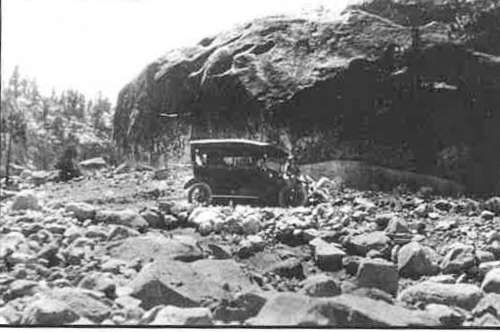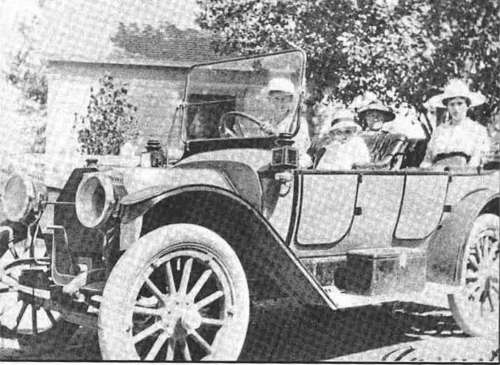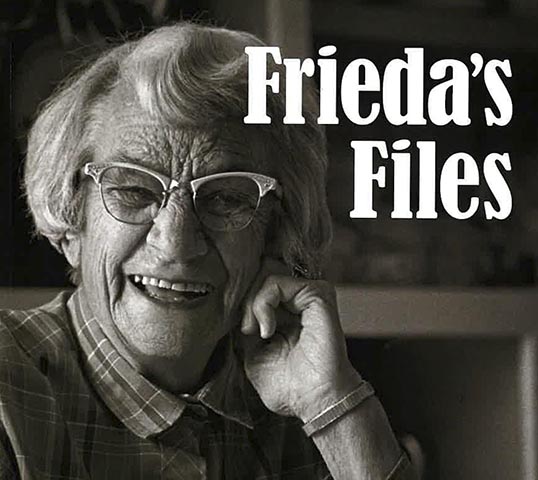Frieda’s Files are a collection of historical short stories about Carson Valley by Frieda Cordes Godecke, published in The Record-Courier. Reproduced here with permission from the Cordes Cousins, and their book “Frieda’s Files”.
October 12, 1978: Speediest car in Carson Valley?
Was Dr. Gerow’s Overland automobile the speediest car in Carson Valley or did that honor belong to William Graunke’s shiny new Buick? Today the big argument was to be settled for all time
It was Carson Valley Day around 1915. The doctor, proudly seated behind the wheel of his Overland, shifted his goggles a bit and glanced across the road where his challenger, Gene Phillips, was making last-minute adjustments on the Buick he was driving for Graunke.
Both men were dressed appropriately for the occasion, wearing goggles, caps, gauntlet gloves, and long tan dusters. The race track was the dirt road between the new town of Minden and the town of Gardnerville, a good half-mile run.
At the sound of the gun, they were off! Cheering friends waved as they raced by, lost in clouds of dust they ran hood to hood all the way into Gardnerville, but the heat of the day and the terrific speed proved to be too much for the Overland. The Buick came out victorious. Phillips posted later that he had been traveling a bit over 40 miles an hour. Popularity of the Overland began to decline from that day on.
The days of horse and buggy travel were nearing the end. Automobiles were finding their way into Carson Valley from around 1910 to 1912. Perhaps two of the first cars in the valley were a classy Doris car owned by H. F. Dangberg and a Buick owned by H. William (Papa) Starke. Both owners had chauffeurs to drive and care for their cars. The story goes that one day Roy Cardinal, chauffeur for Mr. Dangberg, came upon a group of young boys playing with a rubber ball. He was in need of just such a rubber ball for some job on the car so in payment for it, he gave all the boys a short ride in the Doris, much to their delight.

The Overland
An Overland on the old double S curve in Woodfords Canyon – 1916.
Brass-banded Model T Fords were very popular before 1920. Owners of such cars did not seem to mind the fact that no provision had been made for spare tires. It was necessary at all times to carry tire irons, tube patches, and a good hand pump. Such articles were hidden under the front seat where there was also a space for the gasoline tank. A flat tire could mean at least an hour’s delay on the road. All cars were cranked by hand, and the Model T was a bit temperamental in this regard, especially during cold weather. Sometimes a back wheel had to be jacked up to aid in the starting. One Carson Valley resident had difficulty starting his Model T on a cold morning. He had heard of jacking up a wheel and decided to give it a try. However, not knowing a great deal about the mechanism of a car and assuming a wheel was a wheel, he jacked-up the front wheel instead of the back one. This was of no help so he decided the information had been worthless.
A presto tank on the running board provided the fuel for the lights on the cars at that time. A tube lead from the tank to the lamps and was lit with a match. A pneumatic rubber horn, honked by hand, was conveniently located near the steering wheel. The spare tire fit into a groove in the fender or was strapped to the side of the car. There were no trunks on the early cars. This was the era when it was popular to adorn the radiator cap with beautiful ornaments such as the American flag, a golden eagle, a crouching lion, Hercules, or any other interesting symbol. Early cars featured right-hand drives, and very often the shifting gears were placed in the area that is now the front right door. Linoleum covered the floors of the cars.
Patience and stamina were put to a severe test if one was brave enough to venture forth in very cold weather. Since there were no heaters or defrosters, other means to keep the car and passengers from freezing were resorted to. The top, folded back on the rear of the car for the summer, was pulled up into place and isinglass side curtains were carefully snap to the top. These side curtains were by no means foolproof, but they did keep the snow and rain out to a great extent. Every car carried warm robes and blankets at all times. Anti-freeze was unheard of. Radiators were filled with warm water to help in starting the motor. When it became necessary to park the car for any length of time, the radiator was completely covered with a wool blanket, and at half-hour intervals, the driver slipped out to warm up the motor. It was a must to drain the radiator before it was put away for the night. A glycerin mixture used in the 1920s proved unsatisfactory.
Summer motoring had its problems just as the winter months did. The early four-cylinder cars often had difficulty traveling over rough sandy mountain roads. Sometimes it took the combined power of gasoline and that of man-powered pushing from the rear, to reach the top of the steep hill. It was wise to carry several canvas bags filled with water to cool the radiator after such an ordeal.
Winter or summer, it was also wise to carry a strong rope or chain in a car. There was always danger of sliding into a mud hole or skating in the sand and needing the help of a passer-by or a farmer living near the road.
Thirty to 35 mph was considered a fast clip. A faster speed made it difficult to control a car over the rough wagon-rutted roads and to allow for the raised area where the culvert crossed the road. Springs on cars broke easily and it was well to keep them in mind when hitting a chuck hole or crossing a culvert.

The Buick
All dressed up for a ride in the Buick – August, 1916.
Accidents? Yes, there were accidents even in those days. There were times when a car missed a bridge or culvert or when a driver lost control on a rough road. Such was the case when a candy salesman, coming into the Valley from Reno, upset his car, scattering his cargo of candy in the sagebrush. It happened not too far from town, so the young fry had a holiday picking up the spoils in the brush.
Perhaps the greatest danger was not to the automobile but what the automobile did to the horse and buggy. Most horses were extremely frightened by the noisy monsters that were suddenly appearing on the country roads. Many serious runaways occurred with disastrous results to both wagon and passengers. It was wise to give an approaching car ample room, and if it were at all possible, to drive to the side of the road and tie the horse securely to the fence post until the automobile had passed by.
As the years went by, touring cars became sedans, spare tires and tools were hidden in trunks, anti-freeze came into use, and shock absorbency, heaters, air conditioners, and radios made riding more pleasant. Today as we enjoy all the pushbutton convenience of the modern car, we look back over the years and feel we have indeed come along way.




